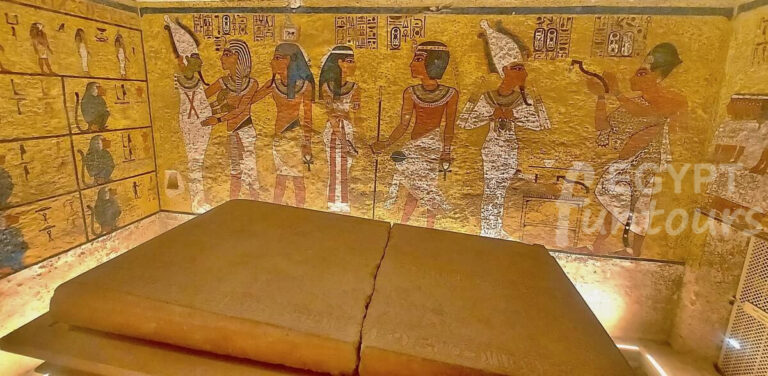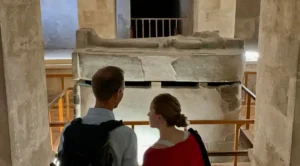Giza Pyramids Complex
The most well-known tourist site in the entire globe is the Giza Pyramids. The great pyramid was the highest building in the world for a very long time. Nine pyramids from the fourth dynasty may be seen on the plateau; they were all built for royal funerals and to be the monarchs’ ultimate resting places. The Great Pyramid of Giza is the only one of the ancient seven wonders of the world that is still intact, making it stand out among the other 118 Egyptian pyramids.
King Khufu, the second ruler of the fourth dynasty, is buried there. The Pyramid of King Mycarinus is the smallest of the three Giza Pyramids, whereas the Pyramid of King Khafra, his son, is the second-largest pyramid in the entire globe. The wives and sisters of the Kings are honoured by the other six pyramids at Giza. To the east of the large pyramid are three smaller pyramids that belonged to Queen Henutsen, Khufu’s wife; Hetephereth, his daughter; and a third little pyramid that belonged to an unidentified Royal female. The six miniature pyramids’ last three structures belonged to King Mykarinus’ wives.
Great Pyramid of King Khufu (Giza Pyramids Facts)
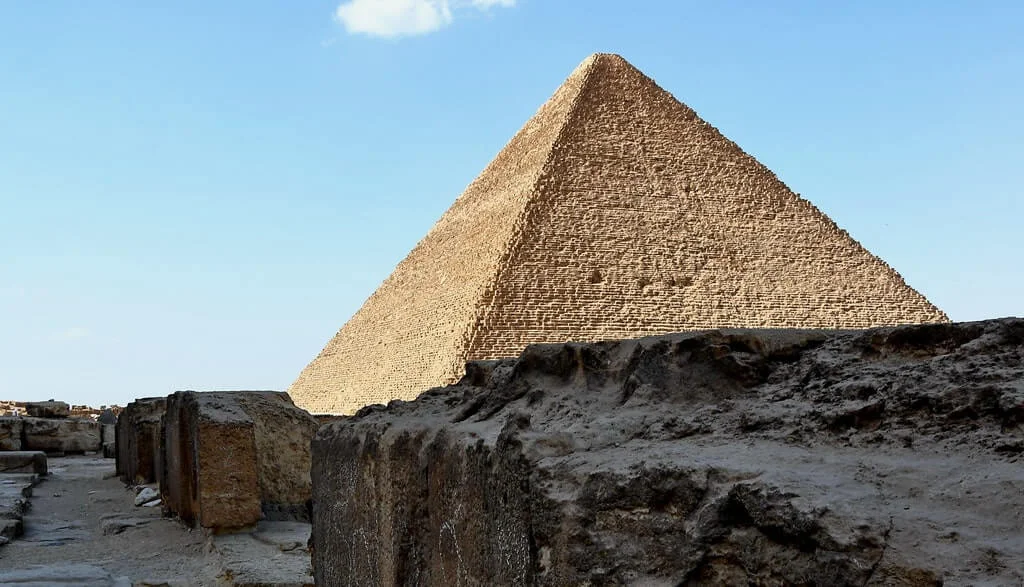
The largest pyramid ever built is the great pyramid of King Khufu. Its original height was 146 metres, but due to the removal of the limestone outer casing, it has subsequently lost a few metres in height. It occupies a 13-acre parcel of ground and is 230 metres long on each side. The pyramid’s four sides match the four initial directions of north, south, east, and west, and the slope angle is 50.50 degrees.
The Pyramid was formerly part of a massive complex that stretched from the modern town of Nazlet El-Seman, where King Cheops’ valley temple stood, to the western side of the Pyramid itself, where tourists can today view the workers and Noble tombs. This complex was made up of
- The main tomb (the pyramid)
- The tomb’s entrance to the northern side of the Pyramid
- The funeral temple on the eastern side of the pyramid
- The valley temple
- The funeral temple and the valley temple are linked by a causeway.
- The enclosure wall surrounding the complex
Inside the Great Pyramid: A Look Within
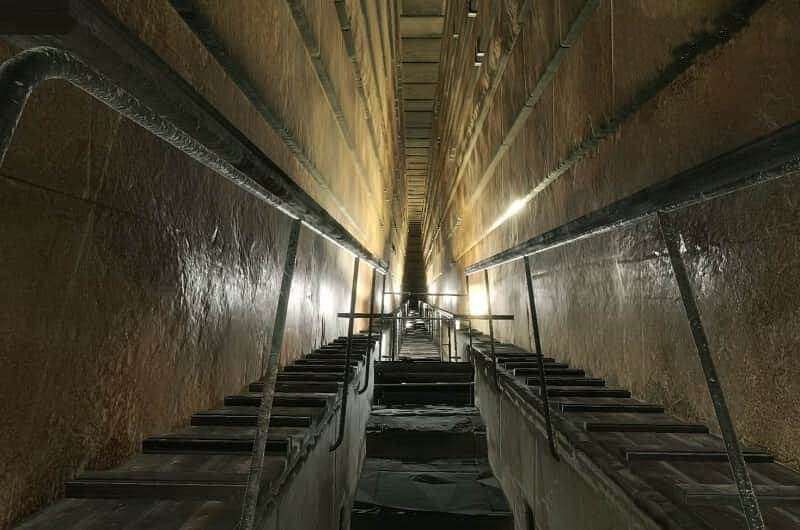
Except for three rooms and a few passageways, the pyramid’s interior is massive. The original entrance to the Great Pyramid is on its northern side, and people have shut it since the king’s reign. El-Khalife Ma’moon’s workers hewed another entrance into the rock in the 11th century as he hunted for King Khufu’s wealth.
From the original entry, a 100-meter descending vestibule leads to the so-called blind chamber. Workers dug this chamber with the intention of it becoming the king’s resting place, but they left it unfinished, hence the term “blind.” After 35 meters, a 36-meter ascending vestibule begins. Another horizontal vestibule follows, leading to the second room, known as “the Queen’s Chamber.” People assumed they created this chamber for Khufu’s wife, but this was not the case, since they also intended this chamber to house the king’s mummies!
The King’s Burial Chamber and Beyond
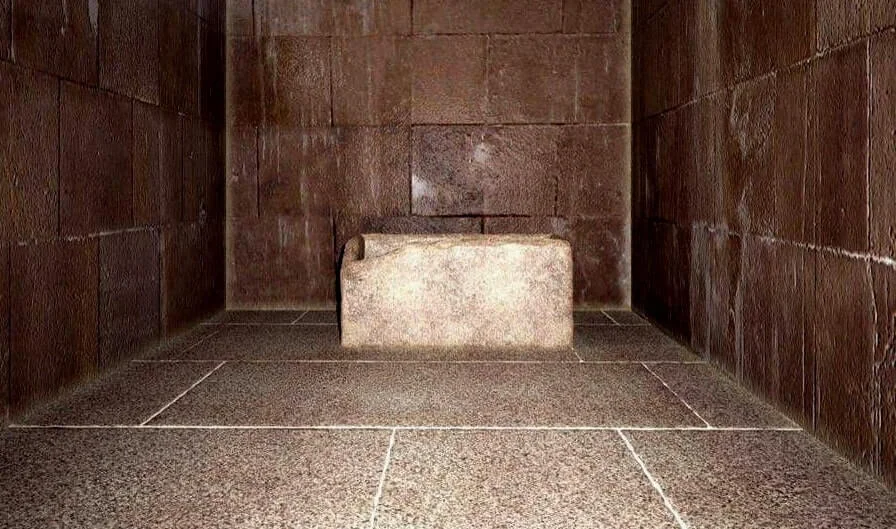
The vestibule continues up from the Queen’s room. It leads to a great gallery, 48 meters long. This gallery connects to the third chamber. This is King Khufu’s real burial chamber. Archaeologists discovered the monarch’s stone sarcophagus within this third room. However, they found it empty and damaged. It had no lid. This indicates someone stole the mummy, valuables, and even the lid. The sarcophagus’s width and height are greater than the room’s entrance. This indicates workers placed the sarcophagus within the chamber. They did this before finishing it and building the ceiling.
5 Vacant Chambers
Above the third chamber are five small, vacant chambers. Builders kept these empty. This was to relieve the pressure of stones above the chamber. Researchers discovered a phrase inscribed in Hieroglyphic. It was in the middle chamber of these five rooms. The inscription reads: “Construction work of the everlasting home of king ‘Khunum-Kha-F-Wi’ has been accomplished in the 23rd year of his reign.” This statement is crucial. It provides the sole proof that the Great Pyramid belonged to Khufu. It also shows ancient Egyptians built it during his reign. It also includes a crucial piece of information: it took 23 years to construct the Great Pyramid.
Exterior and Design
Except for the above-mentioned sentence found within the room above the burial chamber, people never adorned the massive pyramid from the exterior, and we found no inscriptions or writings! The slope angle for the Great Pyramid is 51.52 degrees.
The Pyramid of King Chephren (Giza Pyramids)
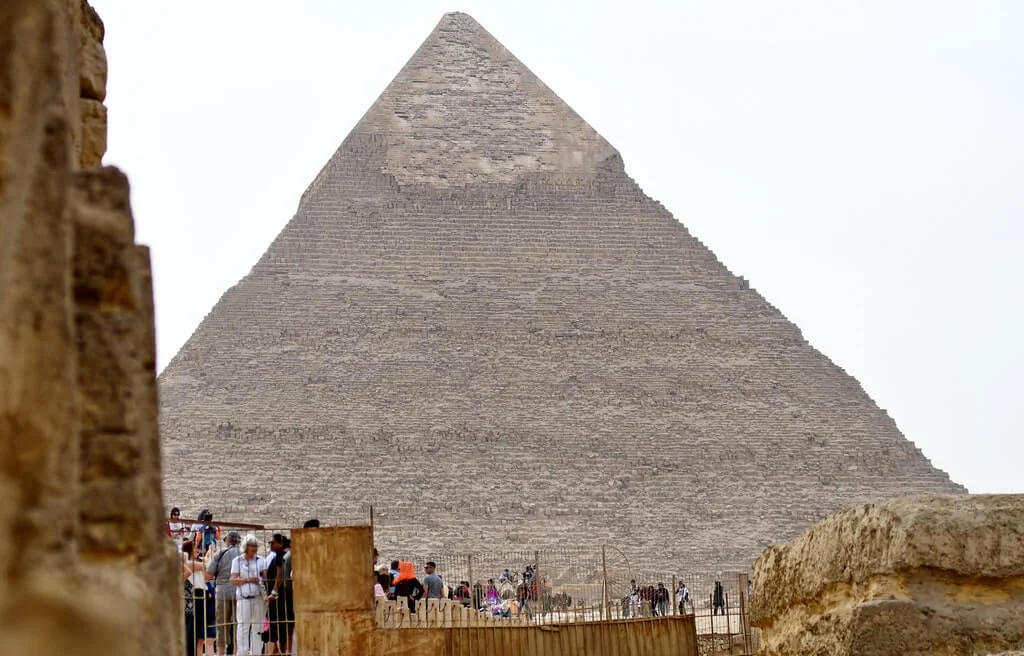
It is yet another huge pyramid, the second biggest in Egypt. It was opened in 1818 by Giovani Batista Belzoni, an Italian tomb thief who was one of the most well-known robbers of the nineteenth century! Unfortunately, some Italian moron inscribed his name on the southern wall of the king’s burial chamber as ” Belzoni March 2, 1818.” The Pyramid stands 137 meters tall with a 210-meter base. Except for the burial chamber, it is entirely made of limestone.
The Pyramid of King Mycarinus
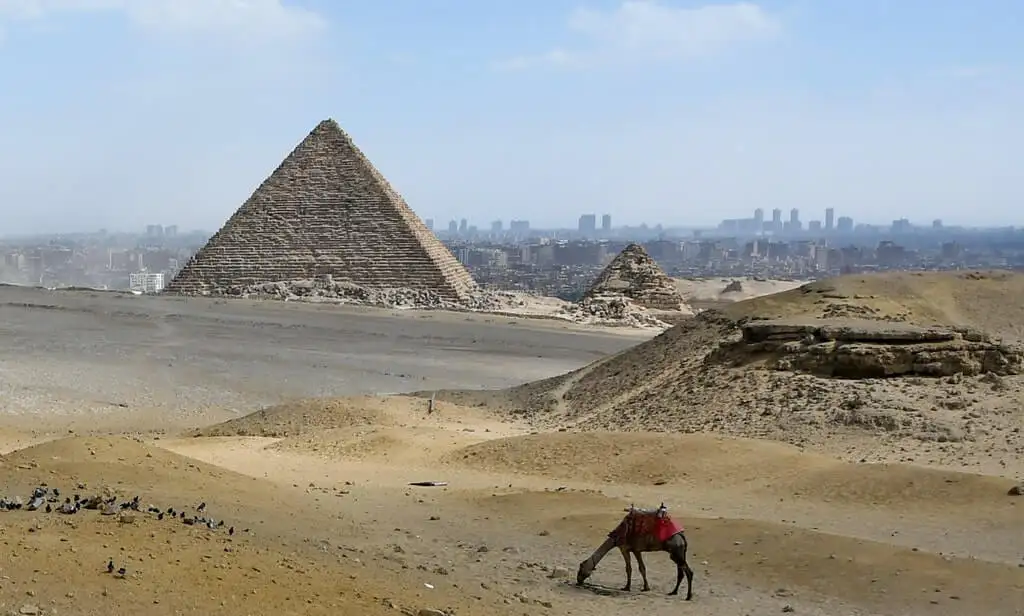
It is the smallest of the Giza 3 Kings pyramids, with a height of 66.5 meters. The monarch died before finishing his pyramid, and his son, King Shepseskaf, finished it. The Pyramid is encased in granite, and it was constructed using limestone quarried from the plateau itself.
In addition, the same Italian thief, Belzoni, stole this Pyramid. Belzoni, the thief of the Giza Pyramids, gathered all of the kings’ wealth, as well as the mummies, and planned to bring it all back to Europe, but his ship broke down in the middle of the Mediterranean, and he perished, along with all of the treasures!
The Queens Pyramids
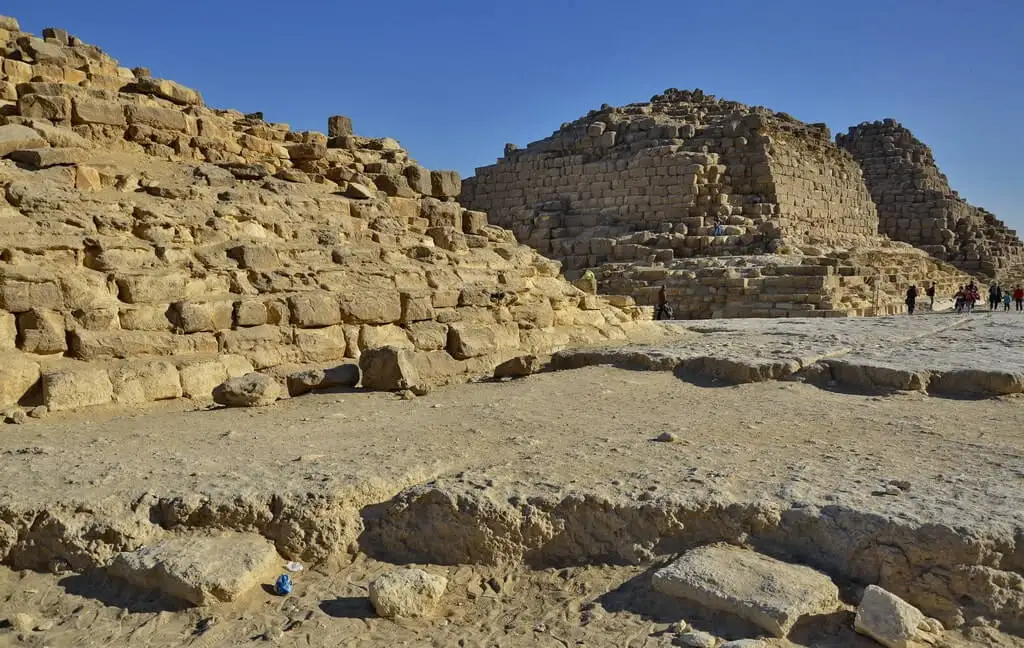
Three small pyramids stand on the eastern side of the Great Pyramid. They belonged to his females. One belonged to his wife, Queen HenotSen. Another belonged to his daughter, HetebHereth. The third belonged to an unnamed female. The smaller minor pyramids are in poor condition on the outside. This is due to poor limestone quality. However, the inside is still in fair condition. To the south of the Mycarinus Pyramid are three tiny pyramids. People say these are for three ladies who were his wives and sisters.
The Great Sphinx
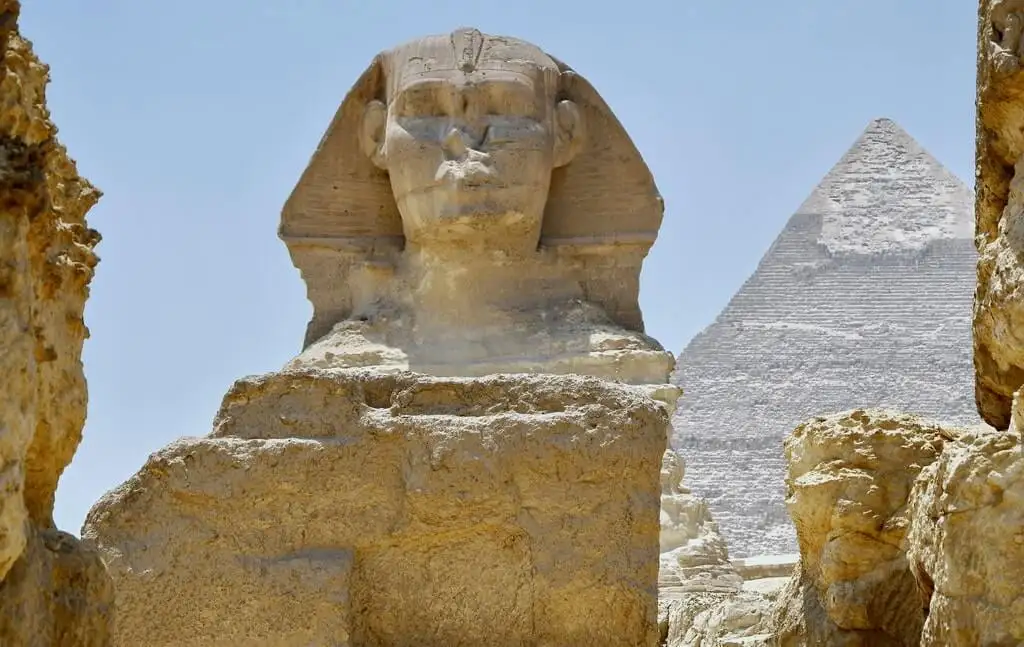
The Giza Complex’s biggest Sphinx, which depicts King Khafrae and is constructed of a single block of limestone measuring 22 meters in height and 72 meters in length, is part of the Giza Complex.
Controversial Theories!!
The Pyramids of Giza and Their Connection to the Belt of Orion
The Pyramids of Giza are one of the world’s most iconic landmarks, and they continue to fascinate and intrigue people from around the globe. People built these monumental structures thousands of years ago, and they have made them the subject of numerous theories and legends, including their connection to the constellation of Orion’s belt. In this article, we’ll explore this fascinating theory and see what it could mean for our understanding of the Pyramids.
The Giza Plateau and Celestial Alignments
The Pyramids of Giza are three massive structures people situated on the Giza plateau, just outside the Egyptian capital, Cairo. Builders constructed them during the Old Kingdom period, more than 4,500 years ago, and we revere them for their precise construction, impressive size, and stunning beauty. But what makes them even more interesting is their alleged connection to the three stars that form the belt of the Orion constellation.
According to some historians and researchers, the orientation of the Pyramids corresponds to the position of the stars in Orion’s belt. The three structures, namely the Great Pyramid, the Pyramid of Khafre, and the Pyramid of Menkaure, they say, match the alignment of the three stars Alnitak, Alnilam, and Mintaka. Several researchers, including the late Robert Bauval, who published a book on the subject called “The Orion Mystery,” popularized this theory.
Examining the Evidence: Skepticism and Speculation
The idea that the stars somehow influenced the Pyramids is certainly intriguing. But does any evidence support this theory? While some researchers have pointed to several similarities between the Pyramids and the Orion constellation, most experts remain skeptical. For starters, the alignment of the stars in Orion’s belt has changed over time, making it difficult to know what the sky looked like when people built the Pyramids. Additionally, while some similarities exist between the layout of the Pyramids and the arrangement of the stars, these could be purely coincidental and not indicate any intentional connection.
Despite the lack of concrete evidence, the theory of the Pyramids’ connection to Orion’s belt continues to capture people’s imaginations, and it has inspired numerous theories and legends over the years. Some people believe that builders constructed the Pyramids to serve as ancient astronomical observatories, while others think that designers intended them as a means of contacting extraterrestrial life. Still, others see the Pyramids as a symbol of ancient Egyptian spirituality and religion.
Ongoing Debate and Intrigue
In conclusion, while the theory of the Pyramids’ connection to Orion’s belt remains controversial and the subject of much debate, it continues to intrigue researchers and the public alike.
The Pyramids of Giza as Power Plants: Exploring a Controversial Theory
The Pyramids of Giza are amongst the most iconic structures in the world, attracting millions of visitors each year, but they continue to remain a mystery. For centuries, historians, archaeologists, and researchers have debated the purpose and function of these massive stone structures. While many theories have been proposed, one idea that has gained popularity in recent years is that the Pyramids were actually advanced energy-generation devices. In this article, we’ll explore this controversial theory and see what evidence there is to support it.
Researchers first proposed the idea that the Pyramids might have been used as power plants in the 20th century. They suggested that these ancient structures could harness the earth’s natural energies to generate electricity.While this theory has received criticism from the scientific community, a growing number of experts believe that there is some merit to the idea.
One of the primary pieces of evidence cited by supporters of this theory is the fact that the Pyramids are located near a considerable magnetic anomaly. This is a region of the earth where the planet’s magnetic field is either stronger or weaker than average, and some theorists believe that this created an ideal environment for energy generation. They propose that the Pyramids acted as giant capacitors, collecting and storing energy from the surrounding magnetic field.
The Pyramids as Ancient Power Plants: Supporting Evidence
Another piece of supporting evidence is that people filled the Pyramids’ interior with various passages and chambers. Some believe they used these to conduct electricity. These passages, people say, consist of conductive materials such as granite. This granite would have been able to transmit the stored energy through the structure and toward the outside world.
Opponents of the power plant theory argue that little concrete evidence supports these claims. They maintain that people primarily used the Pyramids as tombs for the pharaohs of ancient Egypt, and that they consider any other functions attributed to them purely speculative. Furthermore, they argue that the so-called conductive materials people find in the Pyramids are not unique to these structures. Instead, you can find them in numerous other ancient buildings.
While the theory of the Pyramids as power plants remains controversial, it is undoubtedly a fascinating idea that has captured the imagination of many people. While many experts in the field remain unconvinced, it is important to remember that history is full of surprises, and further research might yet uncover new evidence to support this theory. Whether or not the Pyramids really were power plants, one thing is clear: these colossal structures continue to fascinate and inspire people from all over the globe.
The Pyramids of Giza: A Controversial Theory on Their Age
For many years, the Pyramids of Giza have been considered some of the most outstanding creations of ancient architecture. Built nearly 4,500 years ago, these massive structures have managed to withstand the test of time and remain among the world’s most enchanting landmarks. But what if the Pyramids were not as old as previously thought? A controversial theory posits that the Pyramids of Giza could be much older than previously believed. In this article, we’ll explore this theory and consider the evidence put forward to support it.
According to the traditional timeline, the Pyramids of Giza were built between 2589 BC and 2504 BC. This was during the Fourth Dynasty of Egypt’s Old Kingdom. However, growing speculation exists among some researchers. They believe these structures might be much older than previously thought. Some archaeologists believe the Pyramids could be as much as 12,500 years old. This would place their construction nearly 10,000 years earlier than previously believed.
The main argument from supporters of this theory is the Pyramids’ unprecedented scale and complexity. They claim this would have required a level of expertise and technological advancement not possible during the Old Kingdom period. They point out that building these structures would have required vast supplies of stone. This stone could only have been transported to the site using tools and machinery that did not yet exist.
Furthermore, supporters of this theory argue that there is evidence to suggest that the Sphinx, which is located near
The Sphinx: A Sign of Earlier Origins?
Supporters of this theory further argue that evidence suggests the Sphinx, near the Pyramids, could also be much older than previously believed. The Sphinx’s erosion patterns indicate heavy rainfall exposure, which people believe occurred in the region around 10,000 BC. This suggests the Sphinx, along with the Pyramids, could predate traditional historical beliefs.
Challenging the Timeline: Skeptics’ View
Skeptics, however, point out that little evidence supports the idea that people constructed the Pyramids earlier than previously believed. They argue that no archaeological evidence supports this theory. They also emphasize that people have confirmed the Pyramids’ age through carbon dating of materials found within the structures.
The Enduring Mystery of the Pyramids
In conclusion, the Pyramids of Giza remain one of the most fascinating structures ever built. While the conventional timeline places their construction within a relatively narrow timeframe during Egypt’s Old Kingdom period, a growing number of researchers believe these monuments might be much older. While evidence supporting this controversial theory is still quite limited, it remains an intriguing possibility.
Who Built the Pyramids?
One of the most controversial theories about the Pyramids of Giza concerns their construction. Some believe they were built using advanced technology and expertise. This technology was not available during the Old Kingdom period around 2500 BC. Supporters of this theory argue the Pyramids might be much older than previously thought. They could possibly date back over 12,500 years. They point out that these massive structures required vast stone resources. They also needed advanced transportation methods. Only technology that did not exist during the conventional timeline could have achieved this.
Another piece of evidence supports this controversial theory. It is the apparent age of the Sphinx. The Sphinx is located near the Pyramids. Its erosion patterns suggest exposure to heavy rainfall around 10,000 BCE. This indicates it could be much older than previously believed. However, skeptics of this theory point out there is no archaeological evidence. This evidence would confirm the Pyramids’ construction earlier than the traditional timeline. Carbon dating has also confirmed materials within the structures. These materials are consistent with that timeline.
The debate continues
Overall, the debate over the age and construction of the Pyramids continues. It intrigues scholars and enthusiasts alike. Some researchers support the controversial theory. They believe the Pyramids could be much older than previously believed. However, the evidence for this remains limited. Skeptics also contest it. As we continue to learn more about these magnificent structures, further questions and theories will likely arise.
Before you go, check Egypt’s weather, and contact us to arrange your perfect Egypt trip.


